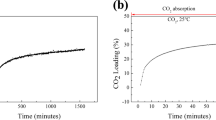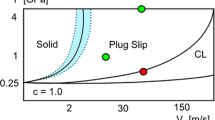Abstract
To demonstrate the concept of the smart lubrication system using liquid crystal (LC) lubricant proposed by Nakano (Tribol Lett 14:17–24, 2003), the following three types of tests were performed: (1) film thickness measurements in pure rolling contacts, (2) friction coefficient measurements in rolling–sliding contacts, and (3) molecular orientation measurements in stationary cells. In all of these types of tests, a nematic LC [4-pentyl-4′-cyanobiphenyl (5CB)] and a carboxylic acid [hexadecanoic acid (HDA)] were used as the base fluid and the additive, respectively. The results of these tests confirm the following mechanism. First, surface films of the HDA additive that spontaneously adsorb onto contact surfaces induce surface anchoring, which has the effect of making 5CB molecules align themselves perpendicular to the surfaces, competing with the flow alignment of 5CB molecules and inducing an increase in the apparent viscosity of 5CB with decreasing entrainment speed. This increase in the apparent viscosity generates a constant friction coefficient region in the Stribeck curve on the left side of the minimum friction coefficient point, resulting in the minimization of friction at various speeds.









Similar content being viewed by others
References
De Gennes, P.G., Prost, J.: The physics of liquid crystals, 2nd edn. Clarendon Press, Oxford (1993)
Carrión, F.J., Martínez-Nicolás, G., Iglesias, P., Sanes, J., Bermúdez, M.D.: Liquid crystals in tribology. Int. J. Mol. Sci. 10, 4102–4115 (2009)
Fischer, T.E., Bhattacharya, S., Salher, R., Lauer, J.L., Ahn, Y.J.: Lubrication by a smectic liquid crystal. Tribol. Trans. 31, 442–448 (1988)
Ruths, M., Steinberg, S., Israelachvili, J.N.: Effects of confinement and shear on the properties of thin films of thermotropic liquid crystal. Langmuir 12, 6637–6650 (1996)
Mori, S., Iwata, H.: Relationship between tribological performance of liquid crystals and their molecular structure. Tribol. Int. 29, 35–39 (1996)
Barchan, G.P., Milaev, A.G., Gumenchuk, I.G.: Effect of the mesomorphic state-isotropic liquid phase transition on lubricating properties of liquid crystalline mixtures. Chem. Technol. Fuels Oils 24, 550–551 (1988)
Artsyukhovich, A., Broekman, L.D., Salmeron, M.: Friction of the liquid crystal 8CB as probed by the surface forces apparatus. Langmuir 15, 2217–2223 (1999)
Li, J., Wang, C., Shang, G., Xu, Q., Lin, Z., Guan, J., Bai, C.: Friction coefficients derived from apparent height variations in contact mode atomic force microscopy images. Langmuir 15, 7662–7669 (1999)
Janik, J., Tadmor, R., Klein, J.: Shear of molecularly confined liquid crystals. 2. Stress anisotropy across a model nematogen compressed between sliding solid surfaces. Langmuir 17, 5476–5485 (2001)
Ważyńska, B., Okowiak, J.A.: Tribological properties of nematic and smectic liquid crystalline mixtures used as lubricants. Tribol. Lett. 24, 1–5 (2006)
Zhang, X., Liu, X., Zhang, X., Tian, Y., Meng, Y.: Ordering of the 7CB liquid crystal induced by nanoscale confinement and boundary lubrication. Liq. Cryst. 39, 1305–1313 (2012)
Gribailo, A.P., Kupreev, M.P., Zamyatnin, V.O.: Effect of liquid crystals on lubricating properties of mineral oils. Chem. Technol. Fuels Oils 19, 342–345 (1983)
Bermúdez, M.D., Martínez-Nicolás, G., Carrión-Vilches, F.J.: Tribological properties of liquid crystals as lubricant additives. Wear 212, 188–194 (1997)
Shen, M., Luo, J., Wen, S., Yao, J.: Nano-tribological properties and mechanisms of the liquid crystal as an additive. Chin. Sci. Bull. 46, 1227–1232 (2001)
Vekteris, V., Mokshin, V.: Tribological research of industrial oil with liquid-crystal additives. Mater. Sci. 44, 730–734 (2008)
Latyshev, V.N., Novikov, V.V., Syrbu, S.A., Kolbashov, M.A.: Tribological properties of some cholesterical liquid-crystal additives. J. Frict. Wear 30, 411–414 (2009)
Mokšin, V.: Investigation of technological properties of cutting fluid with liquid crystal additive. Acad. J. Manuf. Eng. 9, 89–93 (2011)
Novikov, V.V., Latyshev, V.N., Marshalov, M.S., Nuzhdina, E.E., Kolbashov, M.A.: Properties of cutting oils with additives of liquid crystals. J. Frict. Wear 32, 452–456 (2011)
Mokšin, V., Vekteris, V.: Effectiveness of twisted nematic liquid crystals as water based cutting fluid additive and tap lubricant. Mechanics 17, 570–575 (2011)
Nakano, K.: Scaling law on molecular orientation and effective viscosity of liquid-crystalline boundary films. Tribol. Lett. 14, 17–24 (2003)
Johnston, G.J., Wayte, R., Spikes, H.A.: The measurement and study of very thin lubricant films in concentrated contacts. Tribol. Trans. 34, 187–194 (1991)
Wu, S.T., Wu, C.S., Warenghem, M., Ismaili, M.: Refractive index dispersions of liquid crystals. Opt. Eng. 32, 1775–1780 (1993)
Hamrock, B.J., Dowson, D.: Ball bearing lubrication: the elastohydrodynamics of elliptical contacts. Wiley, New York (1981)
Nakano, K., Spikes, H.A.: Process of boundary film formation from fatty acid solution. Tribol. Online 7, 1–7 (2012)
Cui, M., Kelly, J.R.: Temperature dependence of visco-elastic properties of 5CB. Mol. Cryst. Liq. Cryst. 331, 49–57 (1999)
Kimura, Y., Nakano, K., Kato, T., Morishita, S.: Control of friction coefficient by applying electric fields across liquid crystal boundary films. Wear 175, 143–149 (1994)
Acknowledgments
This work was carried out as a part of the “Green Tribology Innovation Network” Project in the area of Advanced Environment Materials of the Green Network of Excellence (GRENE) program funded by the Ministry of Education, Culture, Sports, Science, and Technology (MEXT) in Japan.
Author information
Authors and Affiliations
Corresponding author
Rights and permissions
About this article
Cite this article
Tadokoro, C., Nihira, T. & Nakano, K. Minimization of Friction at Various Speeds Using Autonomous Viscosity Control of Nematic Liquid Crystal. Tribol Lett 56, 239–247 (2014). https://doi.org/10.1007/s11249-014-0404-2
Received:
Accepted:
Published:
Issue Date:
DOI: https://doi.org/10.1007/s11249-014-0404-2




